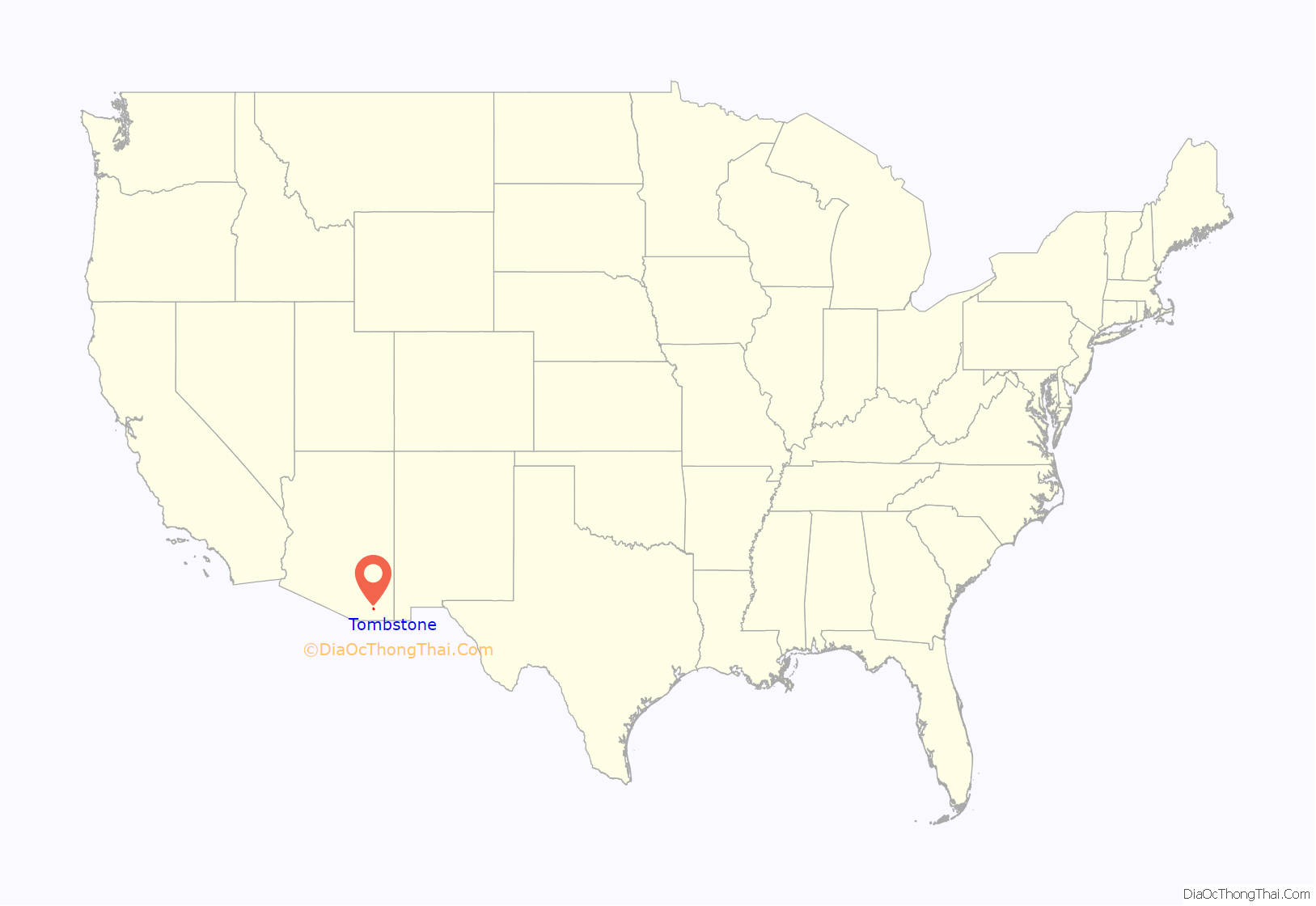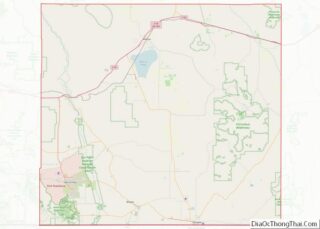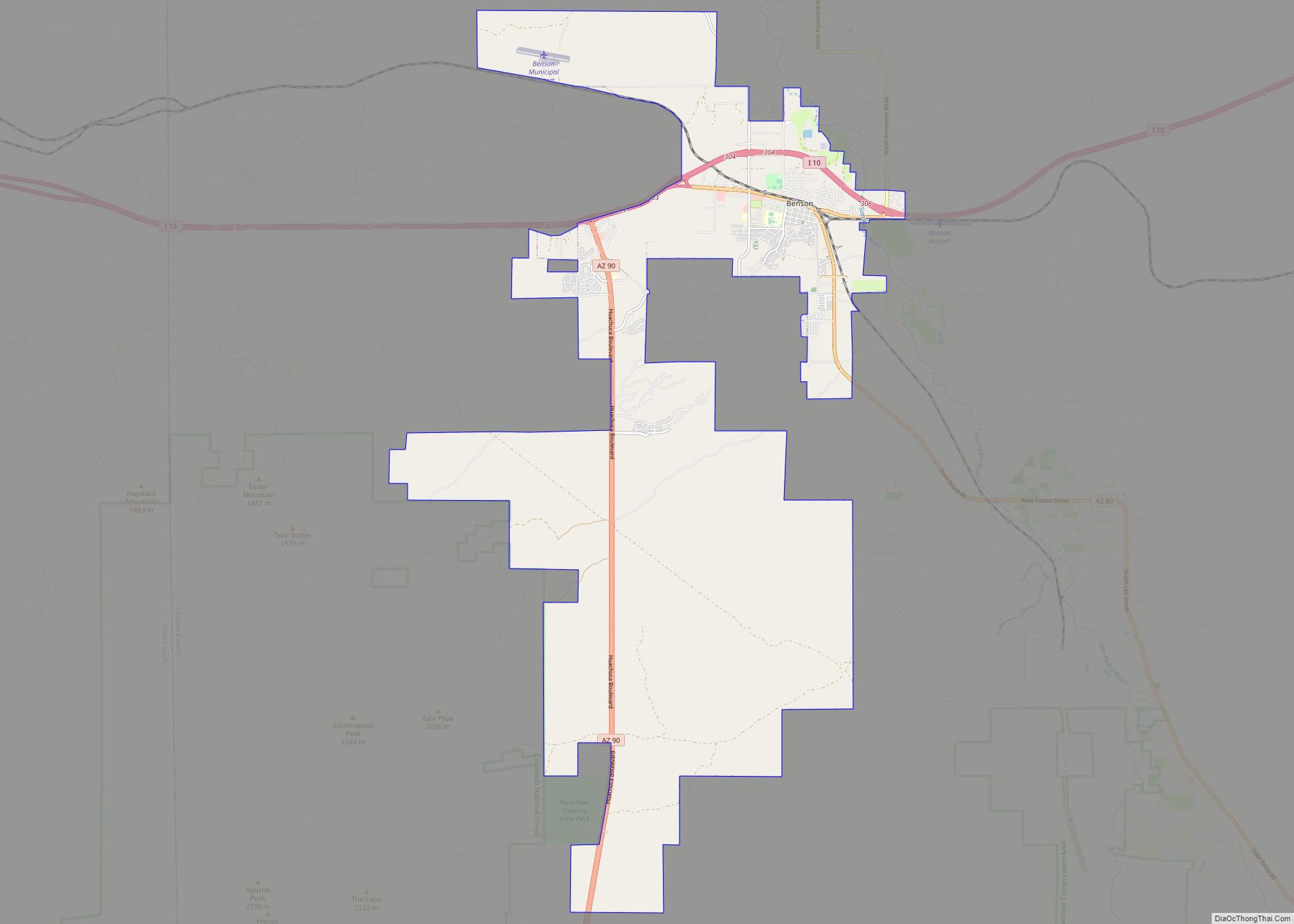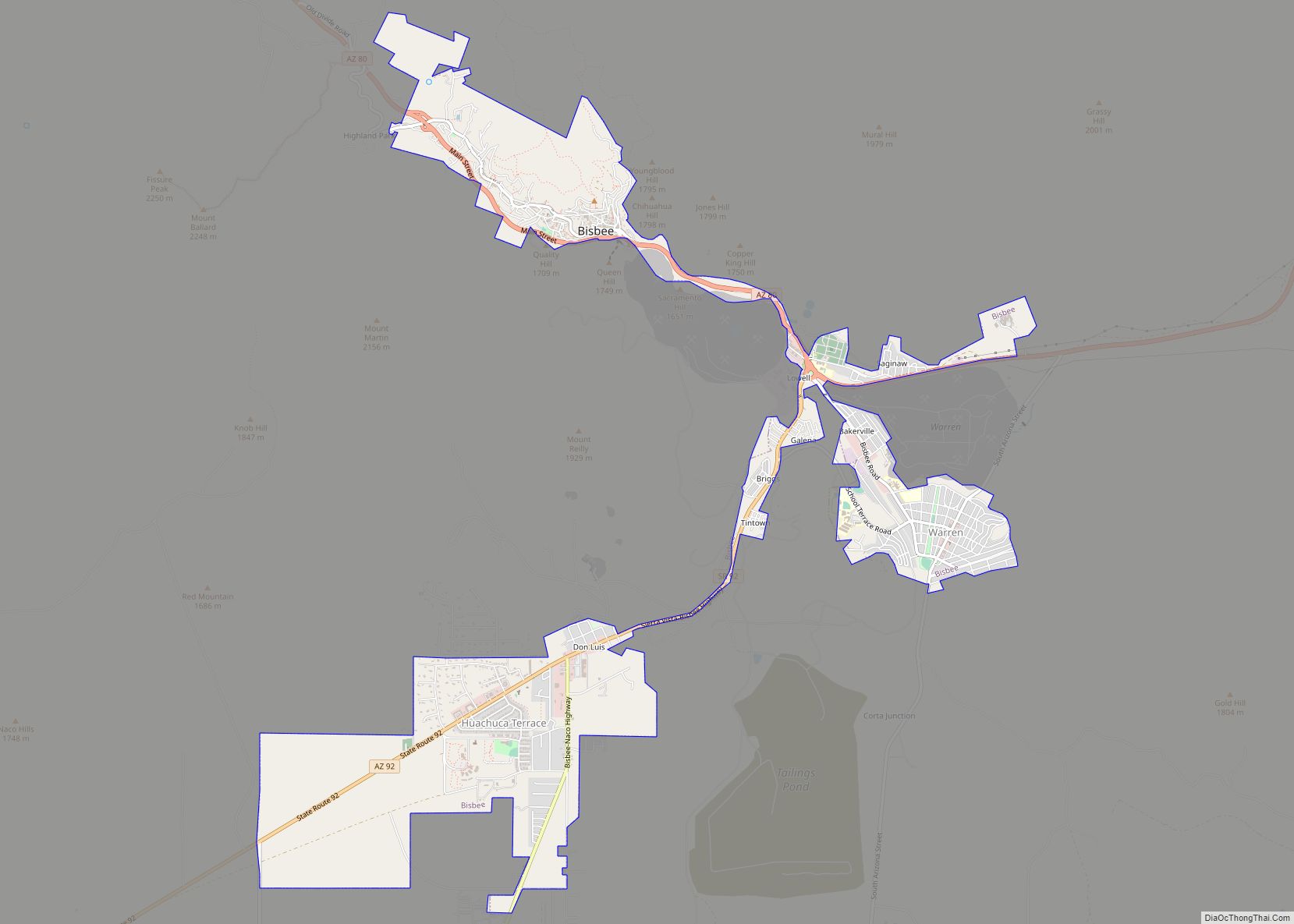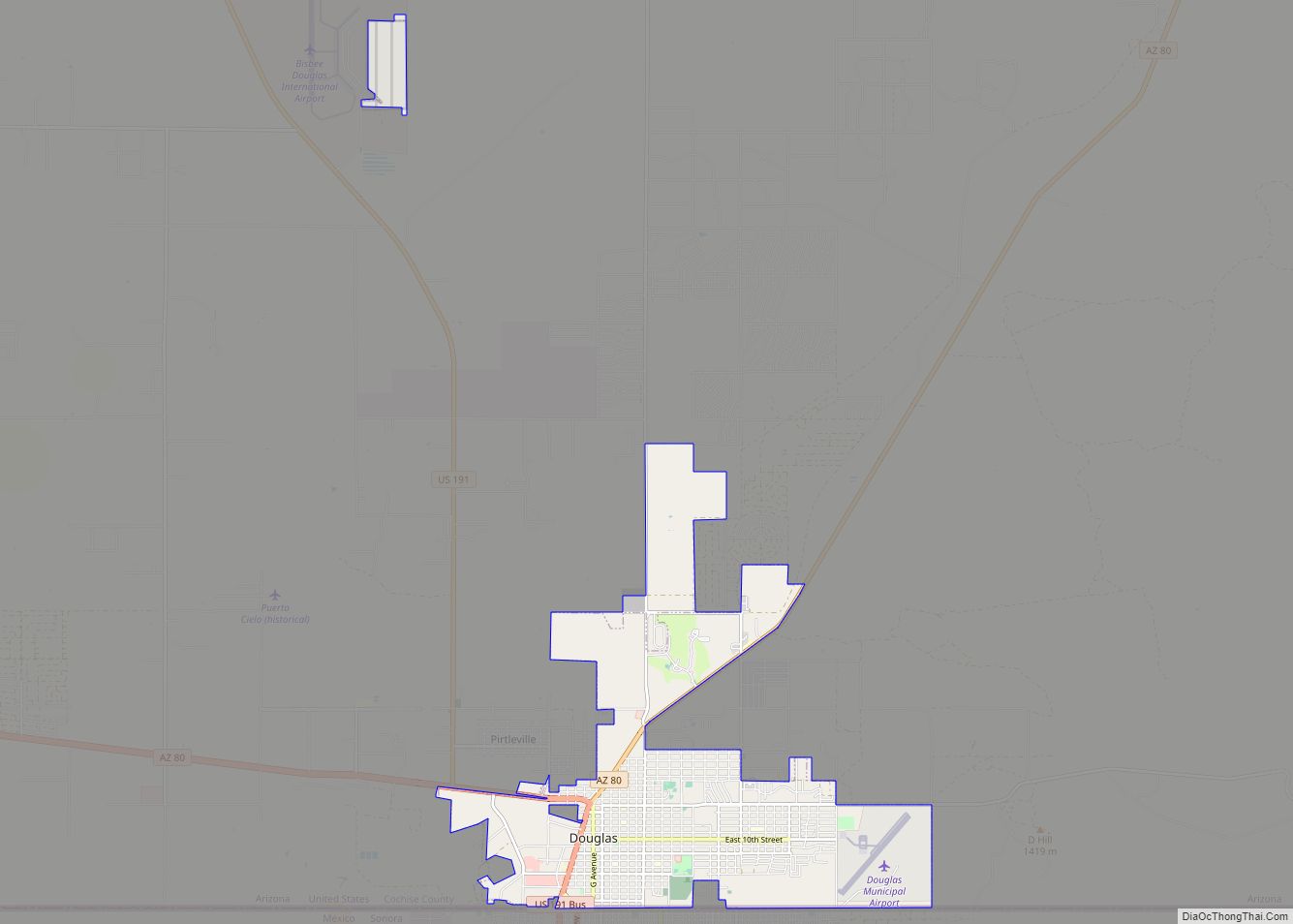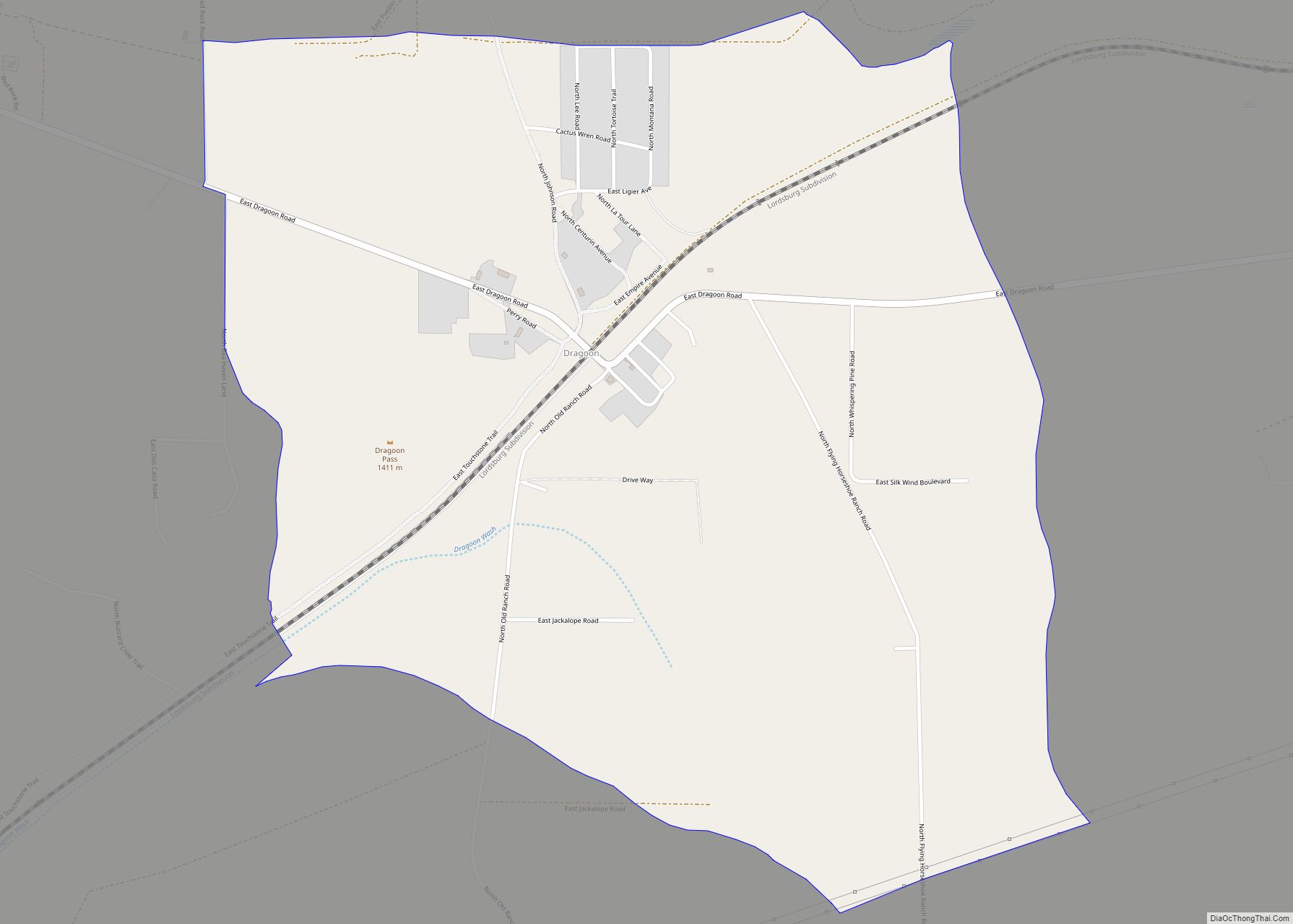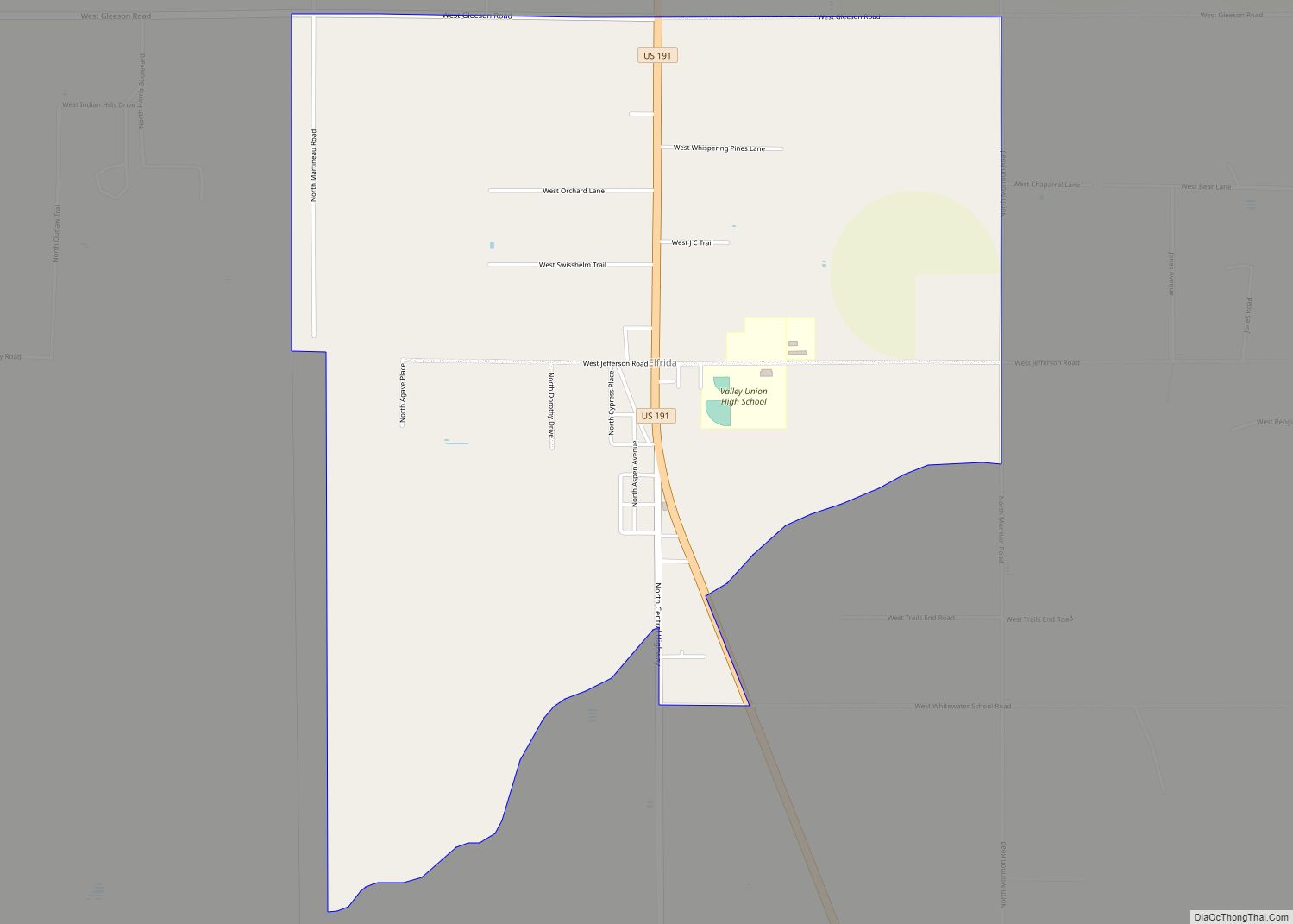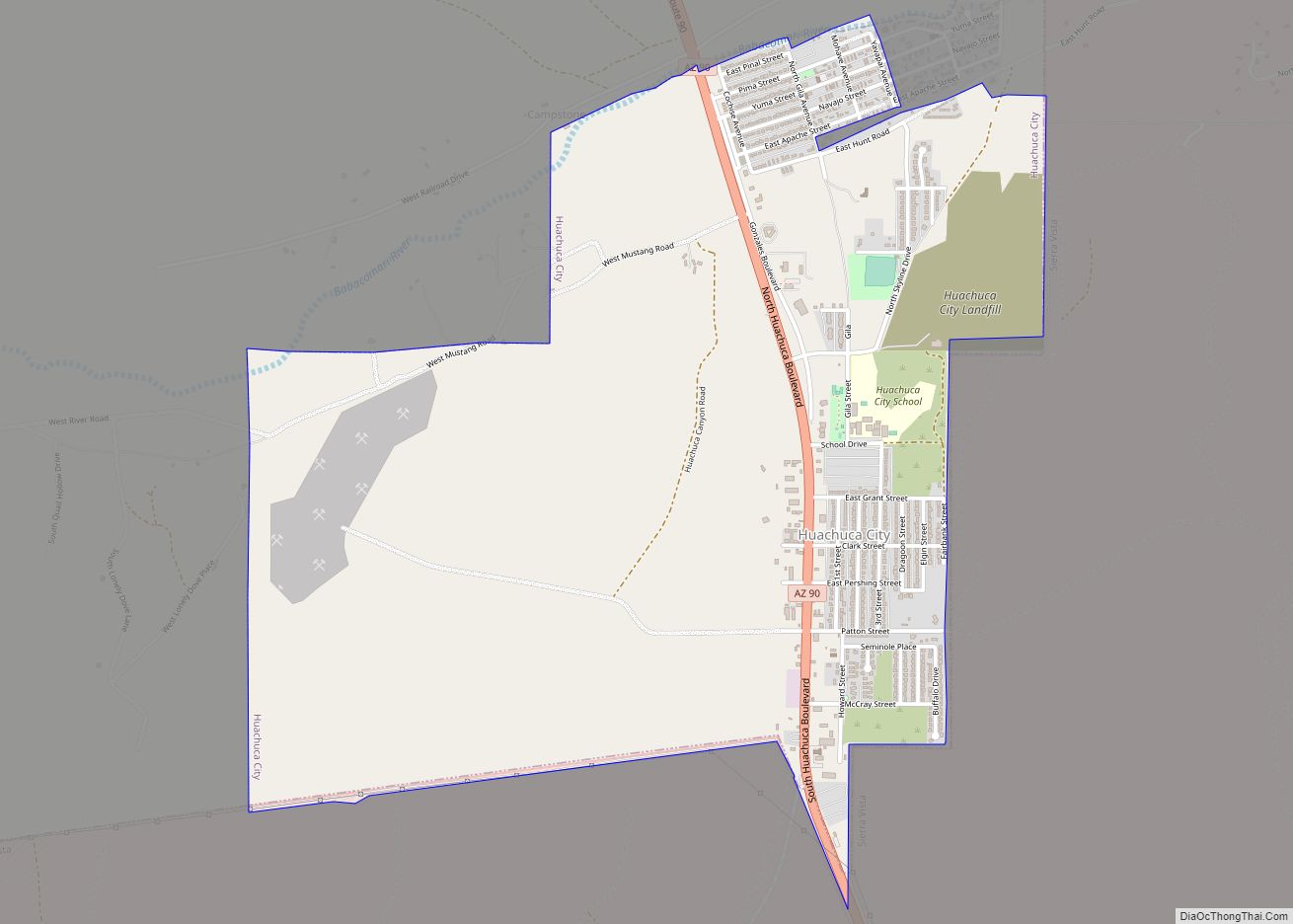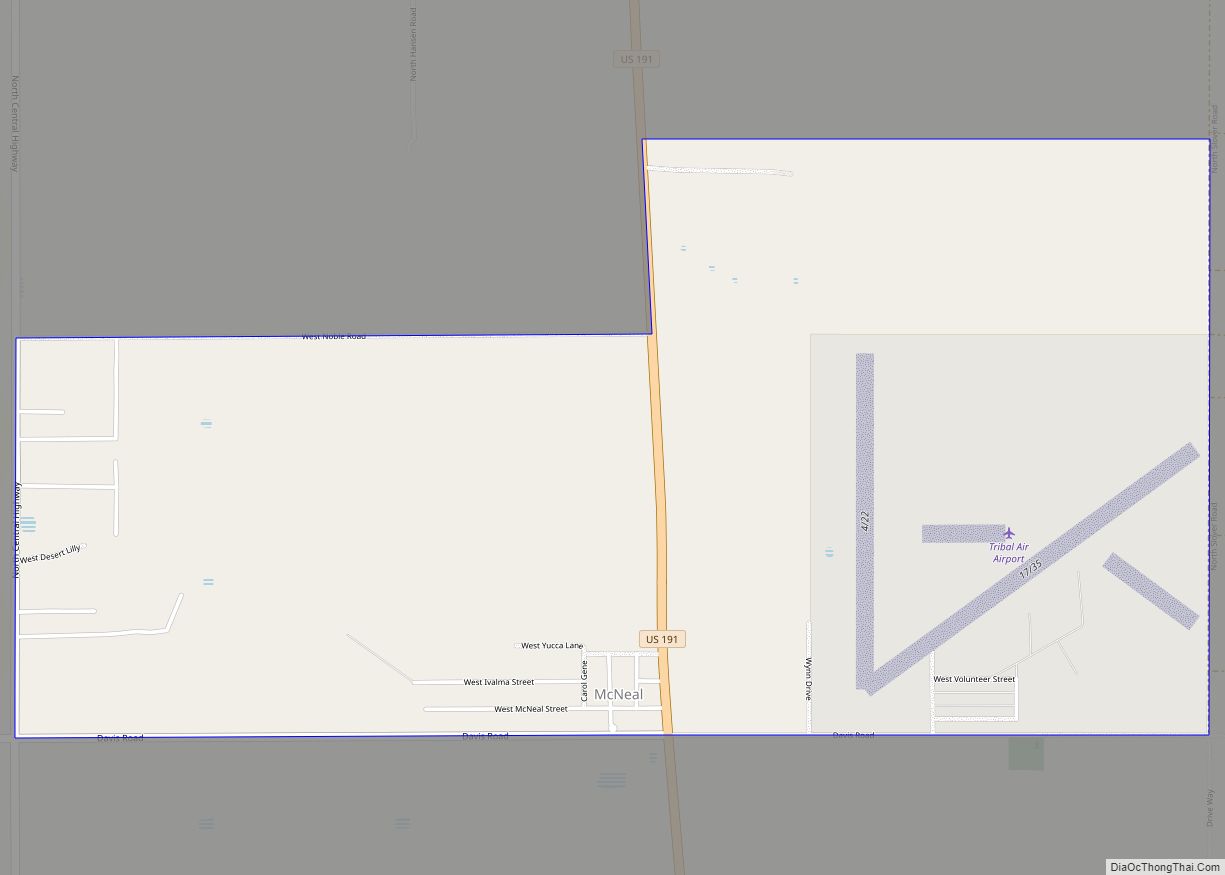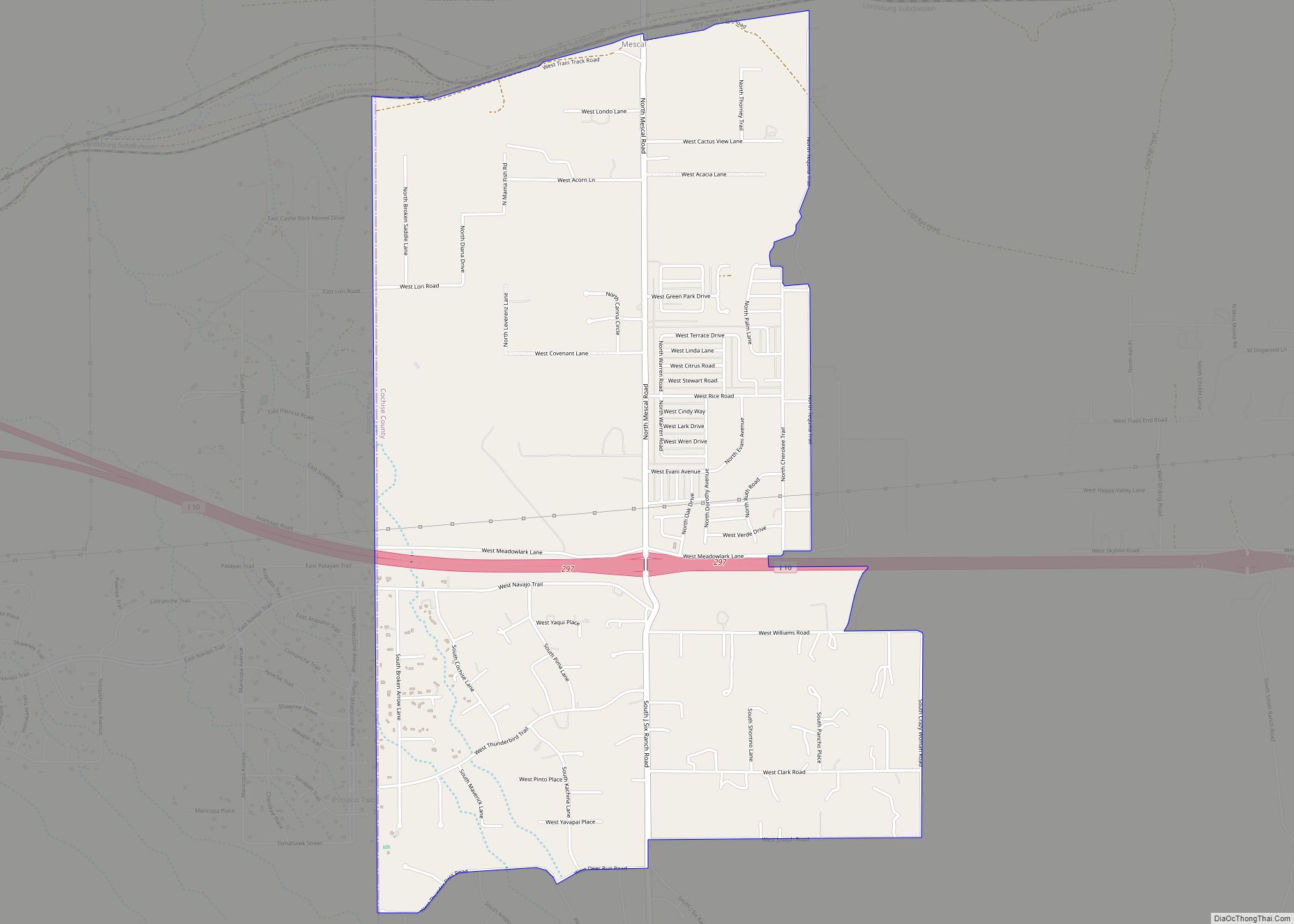Tombstone is a historic city in Cochise County, Arizona, United States, founded in 1879 by prospector Ed Schieffelin in what was then Pima County, Arizona Territory. It became one of the last boomtowns in the American frontier. The town grew significantly into the mid-1880s as the local mines produced $40 to $85 million in silver bullion, the largest productive silver district in Arizona. Its population grew from 100 to around 14,000 in less than seven years. It is best known as the site of the Gunfight at the O.K. Corral and presently draws most of its revenue from tourism.
The town was established on Goose Flats, a mesa above the Goodenough Mine. Within two years of its founding, although far distant from any other metropolitan area, Tombstone had a bowling alley, four churches, an ice house, a school, two banks, three newspapers, and an ice-cream parlor, alongside 110 saloons, 14 gambling halls, and numerous dance halls and brothels. All of these businesses were situated among and atop many silver mines. The gentlemen and ladies of Tombstone attended operas presented by visiting acting troupes at the Schieffelin Hall opera house, while the miners and cowboys saw shows at the Bird Cage Theatre and brothel.
Under the surface were tensions that grew into deadly conflict. The mining capitalists and the townspeople were largely Republicans from the Northern states. Many of the ranchers (some of whom—like the Clantons—were also rustlers or other criminal varieties) were Confederate sympathizers and Democrats. The booming city was only 30 miles (48 km) from the U.S.–Mexico border and was an open market for cattle stolen from ranches in Sonora, Mexico, by a loosely organized band of outlaws known as The Cowboys. The Earp brothers—Wyatt, Virgil and Morgan—as well as Doc Holliday, arrived in December 1879 and mid-1880. The Earps had ongoing conflicts with Cowboys Ike and Billy Clanton, Frank and Tom McLaury, and Billy Claiborne. The Cowboys repeatedly threatened the Earps over many months until the conflict escalated into a shootout on October 26, 1881. The historic gunfight is often portrayed as occurring at the O.K. Corral, though it actually occurred a short distance away in an empty lot on Fremont Street.
In the mid-1880s, the silver mines penetrated the water table and the mining companies made significant investments in specialized pumps. A fire in 1886 destroyed the Grand Central hoist and the pumping plant, and it was deemed unprofitable to rebuild the costly pumps. The city nearly became a ghost town, saved only because it was the Cochise County seat until 1929. The city’s population dwindled to a low of 646 in 1910, but grew to 1,380 by 2010. Tombstone has frequently been noted on lists of unusual place names.
| Name: | Tombstone city |
|---|---|
| LSAD Code: | 25 |
| LSAD Description: | city (suffix) |
| State: | Arizona |
| County: | Cochise County |
| Founded: | 1879 |
| Incorporated: | 1881 |
| Elevation: | 4,539 ft (1,384 m) |
| Total Area: | 9.25 sq mi (23.96 km²) |
| Land Area: | 9.25 sq mi (23.96 km²) |
| Water Area: | 0.00 sq mi (0.00 km²) |
| Total Population: | 1,308 |
| Population Density: | 141.37/sq mi (54.59/km²) |
| ZIP code: | 85638 |
| Area code: | 520 |
| FIPS code: | 0474400 |
| GNISfeature ID: | 12590 |
| Website: | www.cityoftombstone.com |
Online Interactive Map
Click on ![]() to view map in "full screen" mode.
to view map in "full screen" mode.
Tombstone location map. Where is Tombstone city?
History
Founding
Ed Schieffelin was briefly a scout for the U. S. Army headquartered at Camp Huachuca. Schieffelin frequently searched the wilderness looking for valuable ore samples. At the Santa Rita mines in nearby Santa Cruz Valley, three superintendents had been killed by Native Americans. When friend and fellow Army Scout Al Sieber learned what Schieffelin was up to, he is quoted as telling him, “The only rock you will find out there will be your own tombstone”, or, according to another version of the story, “Better take your coffin with you, Ed; you will only find your tombstone there, and nothing else.”
In 1877, Schieffelin used Brunckow’s Cabin as a base of operations to survey the country. After many months, while working the hills east of the San Pedro River, he found pieces of silver ore in a dry wash on a high plateau called Goose Flats. It took him several more months to find the source. When he located the vein, he estimated it to be fifty feet long and twelve inches wide. Schieffelin took on a partner named William Griffith who financed the filing of the claim in return for a later claim for himself. Griffith filed Schieffelin’s first claim, which was named Tombstone, on September 3, 1877. Another account says the first claim was called Graveyard “because it proved worthless and for no other reason.”
When the first claims were filed, the initial settlement of tents and wooden shacks was located at Watervale, near the Lucky Cuss mine, with a population of about 100. The Goodenough Mine strike occurred shortly after. Former Territorial Governor Anson P. K. Safford offered financial backing for a share of the mining claims, and Schieffelin, his brother Al, and their partner Richard Gird formed the Tombstone Mining and Milling Company and built a stamp mill near the San Pedro River, about 8 miles (13 km) away. As the mill was being built, U.S. Deputy Mineral Surveyor Solon M. Allis finished surveying the new town’s site in March 1879. The tents and shacks near the Lucky Cuss were moved to the new town site on Goose Flats, a mesa above the Goodenough Mine at 4,539 feet (1,383 m) above sea level and large enough to hold a growing town. Lots were immediately sold on Allen Street for $5.00 each. The town soon had some 40 cabins and about 100 residents. At the town’s founding in March 1879, it took its name from Schieffelin’s initial mining claim. By fall 1879, a few thousand hardy souls were living in a canvas and matchstick camp perched amidst the richest silver strike in the Arizona Territory.
When Cochise County was formed from the eastern portion of Pima County on February 1, 1881, Tombstone became the new county seat. Telegraph service to the town was established that same month. In early March 1880, the Schieffelins’ Tombstone Mining and Milling Company which owned the original Goodenough Mine and the nearby Tough Nut Mine (among others), was sold to investors from Philadelphia. Two months later, it was reported that the Tough Nut Mine was working a vein of silver ore 90 feet (27 m) across that assayed at $170 per ton, with some ore assaying at $22,000 a ton.
On September 9, 1880, the richly appointed Grand Hotel was opened, adorned with fine oil paintings, thick Brussels carpets, toilet stands, elegant chandeliers, silk-covered furniture, walnut furniture, and a kitchen with hot and cold running water. At the height of the silver mining boom, when the population was about 10,000, the city was host to Kelly’s Wine House, featuring 26 varieties of wine imported from Europe, a beer imported from Colorado named “Coors”, cigars, a bowling alley, and many other amenities common to large cities.
Early conflicts
Under the surface were other tensions aggravating the simmering distrust. Most of the Cowboys were Confederate sympathizers and Democrats from Southern states, especially Texas. The mine and business owners, miners, townspeople and city lawmen including the Earps were largely Republicans from the Northern states. There was also the fundamental conflict over resources and land, with traditional, Southern-style “small government” agrarianism of the rural Cowboys contrasted to Northern-style “big-government” development.
In the early 1880s, smuggling and theft of cattle, alcohol, and tobacco across the U.S./Mexico border about 30 miles (48 km) from Tombstone were common. The Mexican government taxed these items heavily and smugglers earned a handsome profit by sneaking these products across the border. The illegal cross-border smuggling contributed to the lawlessness of the region. Many of these crimes were carried out by outlaw elements labeled “Cow-boys”, a loosely organized band of friends and acquaintances who teamed up for various crimes and came to each other’s aid. The San Francisco Examiner wrote in an editorial, “Cowboys [are] the most reckless class of outlaws in that wild country…infinitely worse than the ordinary robber.” At that time during the 1880s in Cochise County it was an insult to call a legitimate cattleman a “Cowboy”. Legitimate cowmen were referred to as cattle herders or ranchers. The Cowboys were nonetheless welcome in town because of their free-spending habits, but shootings were common.
Gunfight at the O.K. Corral
On the evening of March 15, 1881, three Cochise County Cowboys attempted to rob a Kinnear & Company stagecoach carrying $26,000 in silver bullion (about $730,000 in today’s dollars), en route from Tombstone to Benson, Arizona, the nearest railroad freight terminal. Near Drew’s Station, just outside Contention City, the popular and well-known driver Eli “Budd” Philpot, and a passenger named Peter Roerig riding in the rear dickey seat, were both shot and killed. Deputy U.S. Marshal Virgil Earp, with his temporary deputies and brothers Wyatt Earp and Morgan Earp, pursued the Cowboys suspected of the murders. That set off a chain of events that culminated, on October 26, 1881, in a gunfight in a vacant lot owned by photographer C. S. Fly near, but not in or at, the O.K. Corral, during which the lawmen and Doc Holliday killed Tom McLaury, Frank McLaury, and Billy Clanton.
The gunfight was the result of a personal, family, and political feud. Two months later, on the evening of December 28, 1881, Virgil Earp was ambushed and seriously wounded on the streets of Tombstone by hidden assailants shooting from the second story of an unfinished building. Although identified, the suspects provided witnesses who supplied alibis, and the men were not prosecuted. On March 18, 1882, while Morgan Earp was playing billiards at 10 p.m. at Campbell & Hatch in Allen Street — in the heart of Tombstone’s still-current downtown — he was killed by a shot that struck his spine, as Wyatt looked on. Once again, the assailants were named but escaped arrest due to legal technicalities. Wyatt Earp, concluding that official justice was out of reach, but with warrants obtained via the U. S. Marshal’s Office, led a posse on what became known as the Earp Vendetta Ride, pursuing and killing four of the men they held responsible.
Much of the Cowboy-related crime subsided after the Earp family left Arizona in early 1882, following the attempted murder of Tombstone Marshal Virgil Earp on 28 December 1881, and the murder of Deputy Marshal Morgan Earp on 18 March 1882. John Slaughter was elected Cochise County Sheriff in 1886 and served two terms. He hired Burt Alvord, who as a 15-year-old boy had witnessed the shootout between the Earps and Cowboys. Alford served very effectively for three years until he began to drink heavily and associate with outlaws, as had Earp-era County Sheriff Johnny Behan, a close friend and constant protector of the law-breaking Clanton family and their friends.
Boothill Graveyard
Tom McLaury, Frank McLaury, and Billy Clanton, killed in the O.K. Corral shootout, are among those buried in the town’s Boothill Graveyard. Of the number of pioneer Boot Hill cemeteries in the Old West, so named because most of those buried in them had “died with their boots on”, Boothill in Tombstone is one of the best-known.
Silver mining
Tombstone boomed, but founder Ed Schieffelin was more interested in prospecting than owning a mine. Ed was one-third partners with his brother Al Schieffelin and Richard Gird. There were several hundred mining claims near Tombstone, although the most productive were immediately south of town. These included the Goodenough, Toughnut, Contention, Grand Central, Lucky Cuss, Emerald, and Silver Thread. Due to the lack of readily available water near town, mills were built along the San Pedro River about 9 miles (14 km) away, leading to the establishment of several small mill towns, including Charleston, Contention City, and Fairbank.
Schieffelin left Tombstone to find more ore and when he returned four months later, Gird had lined up buyers for their interest in the Contention claim, which they sold for $10,000. It would later yield millions in silver. They sold a half-interest in the Lucky Cuss, and the other half turned into a steady stream of money. Al and Ed Schieffelin later sold their two-thirds interest in the Tough Nut for $1 million, and sometime later Gird sold his one-third interest for the same amount.
There are widely varying estimates of the value of gold and silver mined during the course of Tombstone’s history. The Tombstone mines produced 32 million troy ounces (1,000 metric tons) of silver, more than any other mining district in Arizona. In 1883, writer Patrick Hamilton estimated that during the first four years of activity the mines produced about US$25,000,000 (approximately $727 million today). Other estimates include US$40 to US$85 million (about $1.21 billion to $2.56 billion today). Renewed mining is planned for the area.
One of the byproducts of the vast riches being produced, lawsuits became very prevalent. Between 1880 and 1885 the courts were clogged with many cases, often about land claims and properties. As a result, lawyers began to settle in Tombstone and became even wealthier than the miners and those who financed the mining. In addition, because many of the lawsuits required expert analysis of the underground, many geologists and engineers found employment in Tombstone and settled there. In the end, a thorough mapping of the area was completed by experts which resulted in maps documenting Tombstone’s mining claims better than any other mining district of the West.
Mining was an easy task at Tombstone in the early days, ore being rich and close to the surface. One man could pull out ore equal to what three men produced elsewhere. Some residents of Tombstone became quite wealthy and spent considerable money during its boom years. Tombstone’s first newspaper, the Nugget, was established in the fall of 1879. The Tombstone Epitaph was founded on May 1, 1880. As the fastest growing boomtown in the American Southwest, the silver industry and attendant wealth attracted many professionals and merchants who brought their wives and families. With them came churches and ministers. They brought a Victorian sensibility and became the town’s elite. Many citizens of Tombstone dressed well, and up-to-date fashion could be seen in this growing mining town. Visitors expressed their amazement at the quality and diversity of products that were readily available in the area. The men who worked the mines were largely European immigrants. The Chinese did the town’s laundry and provided other services. The Cowboys ran the countryside and stole cattle from haciendas across the international border in Sonora, Mexico.
When the railroad was not built into Tombstone as had been planned, the increasingly sophisticated city of Tombstone remained relatively isolated, deep in a Federal territory that was largely an unpopulated desert and wilderness. Tombstone and its surrounding countryside also became known as one of the deadliest regions in the West. Water was hauled in until the Huachuca Water Company, funded in part by investors like Dr. George E. Goodfellow, built a 23-mile-long (37 km) pipeline from the Huachuca Mountains in 1881. No sooner was a pipeline completed than Tombstone’s silver mines struck water.
City growth and decline
By mid-1881, there were fancy restaurants, Vogan’s Bowling Alley, 4 churches—Catholic, Episcopal, Presbyterian, and Methodist—an ice house, a school, the Schieffelin Hall opera house, 2 banks, 3 newspapers, and an ice cream parlor, alongside 110 saloons, 14 gambling halls, several Chinese restaurants, French, two Italian, numerous Mexican, several upscale “Continental” establishments, and many “home cooking” hot spots including Nellie Cashman’s famous Rush House and numerous brothels all situated among and on top of a number of dirty, hardscrabble mines. The Arizona Telephone Company began installing poles and lines for the city’s first telephone service on March 15, 1881.
Investors from the northeastern United States bought many of the leading mining operations. The mining itself was carried out by immigrants from Europe, chiefly Cornwall, Ireland and Germany. Chinese and Mexican labor provided services including laundry, construction, restaurants and hotels, but immigrant labor provoked backlash; an “Anti-Chinese League” was formed in the 1880s to boycott Chinese businesses and workers.
The mines and stamping mills ran three shifts. Miners were paid union wages of $4.00 per day working six 10-hour shifts per week. The approximately 6,000 men working in Tombstone generated more than $168,000 a week (approximately $4,885,800 today) in income. The mostly young, single, male population spent their hard-earned cash on Allen Street, the major commercial center, open 24 hours a day.
The respectable folks saw traveling theater shows at Schieffelin Hall, opened on June 8, 1881. On December 25, 1881, the Bird Cage Theatre opened on Allen Street, offering the miners and Cowboys their kind of bawdy entertainment. One of the prime entertainments at the Bird Cage theatre was Cornish wrestling competitions, with the results being regularly published in the UK.
In 1882, The New York Times reported that “the Bird Cage Theatre is the wildest, wickedest night spot between Basin Street and the Barbary Coast.” The Bird Cage remained open 24 hours a day, 7 days a week, 365 days a year until it closed its doors in 1889. Respectable women stayed on the north side of Allen Street. The prostitutes worked the saloons on the south side and in the southeast quarter of the town, as far as possible from the proper residential section north of Fremont Street.
By late 1881 Tombstone had more than 7,000 citizens, excluding all Chinese, Mexicans, women and children residents. At the height of the town’s boom, the official population reached about 10,000, with several thousand more uncounted. In 1882, the Cochise County Courthouse was built at a cost of around $45,000.
Fires
Due to poor building practices and poor fire protection common to boomtown construction, Tombstone was hit by two major fires. On June 22, 1881, the first fire destroyed 66 businesses making up the eastern half of the business district. The fire began when a lit cigar ignited a barrel of whiskey in the Arcade Saloon.
On May 25, 1882, another, more destructive fire started in a Chinese laundry on Fifth Street between Toughnut and Allen streets. It destroyed the Grand Hotel and the Tivoli Saloon before it jumped Fremont Street, destroying more than 100 businesses and most of the business district. Lacking enough water to put out the flames, buildings in the fire’s path were dynamited to deny the fire fuel. Total damages were estimated to be $700,000, far more than the estimated $250,000 insurance coverage. But rebuilding started right away nonetheless.
In March 1883, along one short stretch of Allen Street, there were drinking establishments in two principal hotels, the Eagle Brewery, Cancan Chop-House, French Rotisserie, Alhambra, Maison Dore, City of Paris, Brown’s Saloon, Fashion Saloon, Miners’ Home, Kelly’s Wine-House, the Grotto, the Tivoli, and two more unnamed saloons.
Mines strike water
The Tough Nut Mine first experienced seepage in 1880. In March 1881, the Sulphuret Mine struck water at 520 feet (160 m). A year later, in March 1882, miners in a new shaft of the Grand Central Mine hit water at 620 feet (190 m). The flow wasn’t at first large enough to stop work, but experienced miners thought the water flow would increase, and it did. Soon constant pumping with a 4 inches (100 mm) pump was insufficient. The silver ore deposits they sought were soon underwater.
Several mine managers traveled to San Francisco and met with the principal owners of the Contention Mine. They talked about options for draining the mines, and found the only system available for pumping water out of mines below 400 feet (120 m) was the Cornish engine which had been used at the Comstock Lode in the 1870s. They bought and installed the huge Cornish engines in the Contention and Grand Central mines. By mid-February 1884, the engines were removing 576,000 US gallons (2,180,000 L; 480,000 imp gal) of water every twenty-four hours. The city merchants celebrated the continued success of mining and the transfer of funds to their businesses. The Contention and the Grand Central found that their pumps were draining the mining district, benefiting other mines as well, but the other companies refused to pay a proportion of the expense.
On May 26, 1886, the Grand Central hoist and pumping plant burned. The fire was so intense that the metal components of the Cornish engine melted and warped. The headworks of the main mine shaft were also destroyed. Shortly afterward, the price of silver slid to 90 cents an ounce. The mines that remained operational laid off workers. Individuals who had thought about leaving Tombstone when the mine flooding started now took action. The price of silver briefly recovered for a while and a few mines began producing again, but never at the level reached in the early 1880s.
Tombstone Road Map
Tombstone city Satellite Map
Geography
The Tombstone District located at 31°42′57″N 110°3′53″W / 31.71583°N 110.06472°W / 31.71583; -110.06472 (31.715940, −110.064827) sits atop a mesa (elevation 4,539 feet [1,383 m]) in the San Pedro River valley between the Huachuca Mountains and Whetstone Mountains to the west, and the Mules and the Dragoon Mountains to the east. According to the United States Census Bureau, the city has a total area of 4.3 square miles (11.2 km), all land.
The silver-bearing Tombstone Hills around the city are caused by a local intrusion of porphyry through a limestone capping.
When actively mined, the silver vein of argentiferous galena (silver-bearing lead ore) was large and well defined. The silver and lead was easily milled and smelted. The lead content sometimes was as much as 50 per cent of the ore, and assays proved the silver content ran as high as $105.00 per ton in 1881 dollars.
The underlying basement rocks are fine-grained Pinal Schist which is intruded by gneissic granite. The outcrop is in a small area south of the principal mines. The overlying Paleozoic quartzite and limestones rock lies on an unconformity with a total thickness ranging from 4,000 to 5,000 feet (1,200 to 1,500 m), and contains 2,500 to 3,500 feet (760 to 1,070 m) of Mississippian Escabrosa Limestone and the Naco Formation limestone of Pennsylvanian age in the upper formations.
Overlying the Naco Limestone is an unconformable Mesozoic series of conglomerate, thick-bedded quartzites, and shales, with two or three lenses of soft, bluish-gray limestone. Into these formations intruded large bodies of quartz monzonite and by dikes of quartz monzonite-porphyry and diorite-porphyry. Structural faulting occurs throughout the district especially immediately south of Tombstone, where the strata are closely folded.
Tombstone District ores have been produced geologically in three or more ways.
They may have been formed in argentiferous (silver-bearing) lead sulfide containing spotty amounts of copper and zinc. These deposits are usually deeply oxidized and enriched by irregular replacement bodies along mineralized fissure zones and anticlinal rolls cut by Paleozoic and Mesozoic sedimentary formations. Ore bodies are often closely associated with newer cross-cutting intrusive dikes of Laramide.
Ore deposits were formed by base metal mineralization occurring with oxidation found in fault and fracture zones in Laramide volcanics and quartz latite porphyry intrusives.
Silver ore was also occurred in manganese oxides with some argentiferous deposits in lenticular or pipe-like replacement bodies along fracture and fault zones, usually in Pennsylvanian-Permian age Naco Group limestones.
See also
Map of Arizona State and its subdivision: Map of other states:- Alabama
- Alaska
- Arizona
- Arkansas
- California
- Colorado
- Connecticut
- Delaware
- District of Columbia
- Florida
- Georgia
- Hawaii
- Idaho
- Illinois
- Indiana
- Iowa
- Kansas
- Kentucky
- Louisiana
- Maine
- Maryland
- Massachusetts
- Michigan
- Minnesota
- Mississippi
- Missouri
- Montana
- Nebraska
- Nevada
- New Hampshire
- New Jersey
- New Mexico
- New York
- North Carolina
- North Dakota
- Ohio
- Oklahoma
- Oregon
- Pennsylvania
- Rhode Island
- South Carolina
- South Dakota
- Tennessee
- Texas
- Utah
- Vermont
- Virginia
- Washington
- West Virginia
- Wisconsin
- Wyoming
